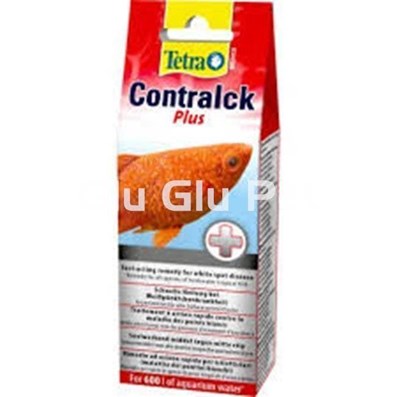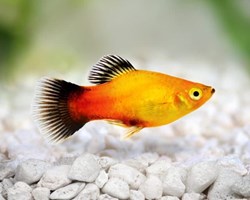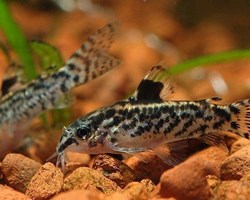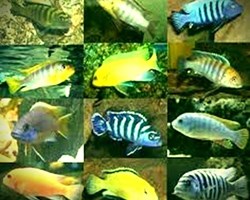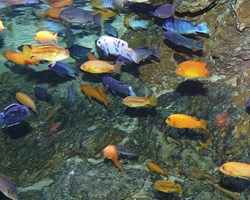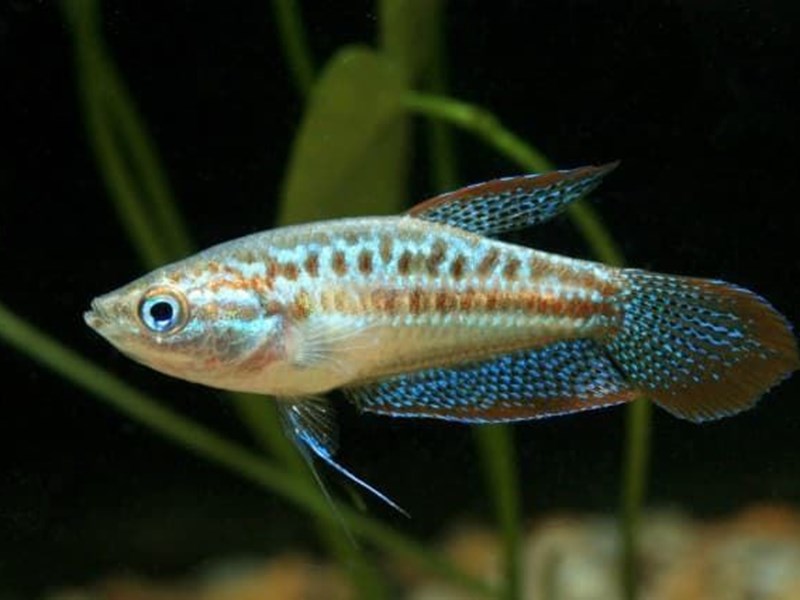
DESCRIPTION:
Trichopsis pumila inhabits areas with little or no current in Vietnam, Cambodia, Sumatra and Thailand.
It is the smallest representative of the genus but not for that less attractive.
Its magnificent livery is silvery gray crossed by two orange-brown rows, the upper one being speckled and the lower one plain.
The fins have iridescent brown and blue dots ending with a red and a blue line.
It is a very calm species that must be kept in a group, otherwise it will be very shy.
Common name:
Dwarf Gourami, Pygmy Gourami, Croador Gourami.
The body length of the sparkling gourami fish is about 4 centimeters; 1.6 inches.
Its body is brown with small light blue spots.
The fins of the fish are light blue with red edges and red patterns on them. His eyes are blue with a thin red rim.
The body shape of the foamy gourami is a bit similar to that of the betta fish, however, the pygmy gourami has shorter fins.
The males have pointed fins and a red stripe that runs across the entire body.
The lifespan of fish in a tank is about 4 years.
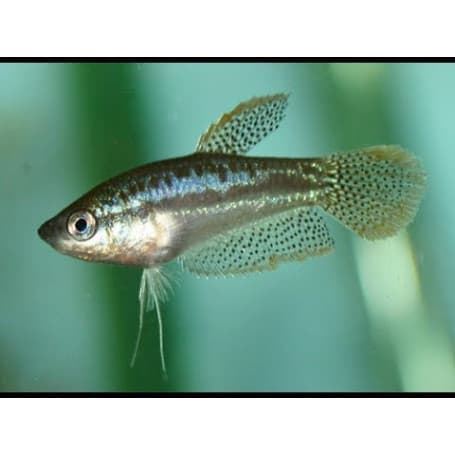
It is a dwarf gourami with a fusiform body and a large mouth.
It hardly reaches a size of 5 cm.
Species with a fusiform body, it has a superiorly arranged mouth and filiform pelvic fins on the lower part of the body, typical of members of the Osphronemidae family.
Its fins are rather small, which maintains a good balance when comparing fins-body, the dorsal is rather triangular in shape and projects vertically when shown to females.
The anal fin does not touch the tail fin and the tail fin is rather rounded.
Its coloration is gray background dotted with green scales, a single line runs horizontally across its body and on it some black dots, when they are adults the background gray color almost disappears and turns completely green.
The eye is metallic blue and throughout the body it has reflections in this same tone.
The color will vary depending on the degree of stress that this peaceful species may have.
Their average life expectancy is 5 years.
Sexual Differences: The fins are longer and end in a point in males.
The females are more robust and are also somewhat less colorful.
Taxonomy:
Animalia Kingdom.
Edge: Chordata.
Class: Actinopterygii.
Subclass: Neopterygii.
Underclass: Teleostei.
Superorder: Acantopterigii.
Order: Perciformes.
Family: Osphronemidae.
Genus: Trichopsis.
Species: T. pumila.
Binomial name: Trichopsis pumila.
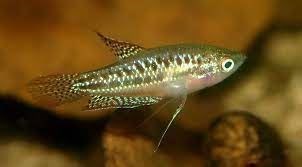
FOR YOUR BEST CARE YOU MUST KNOW ITS BEHAVIOR AND COMPATIBILITY:
Pacifico, even shy at first, usually hides among the aquarium plants until he has adapted to it.
During the acclimatization phase, it will be shy and will not be seen much, but as it gains confidence, it will appear more and more, becoming a very curious species that likes to come out to greet us when we look at the aquarium.
The males are territorial between them but without problems.
They like to be in a group.
When it is in heat or very stressed, it emits a characteristic sound that can be heard perfectly from outside the aquarium. Some authors compare it to the croaking of frogs, others say it resembles a growl.
It is a very calm species that must be kept in a group, otherwise it will be very shy. They should not be associated with very nervous or active fish that can scare them.
THE BEST NUTRITION OF THE SPARKLING GURAMI:
Omnivore. They accept all kinds of food in captivity, they must be provided with a varied diet that includes live food that satisfies their carnivorous need.
In the wild, foamy gourami feed on insects and, in a tank, eat live, artificial foods.
If they get used to it, they will eat flakes, pellets, and other foods like this, but it's still best to feed your fish live and frozen foods.
In the wild they usually feed on small insects that fall into the water or live in it. However, in the tank they will happily feed on dry, live foods.
Sparkling gouramis can also be fed flake food.
Their diet should include live and frozen foods, such as daphnia, brine shrimp, bloodworms, or shrimp meat. Maintaining a diverse diet is especially important for these species, as they rarely feed on aquarium plants and most "leaf" nutrients come from mixed feeds.
Live foods help sparkling gouramis reach their best in terms of size and appearance. Therefore, having a varied and consistent feeding pattern is beneficial to both you as an aquarist and the health of your fish.
In addition to live and frozen foods, you can also feed them freeze-dried foods.
If your fish seems calm at any time, there is probably something wrong with the consistency or the food itself. There are several supplements available to increase the nutritional quality of foods.
Whenever possible, always use high-quality, high-protein foods.
At Glu Glu Pet we recommend the following products:
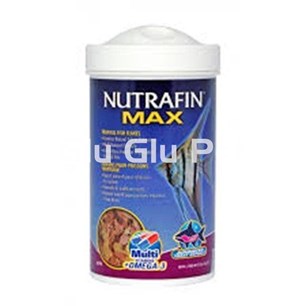
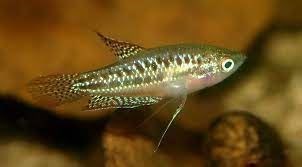
THE REPRODUCTION OF THE SPARKLING GURAMIS:
Sparkling Gouramis can be raised at home, and it's pretty straightforward.
To make breeding as natural as possible, it is best to have around 6 fish in the tank and give them some time to pair up naturally. Alternatively, you can buy a couple of pairs.
Just make sure there are at least 2 females for every male.
Breeding can be stimulated by slightly increasing the temperature, 3-5°F, and lowering the water level to about 6 inches.
Sparkling gouramis are not free spawners, meaning the male will protect and care for the fry.
Parents must be fed live meaty foods before breeding begins.
You can also tell that the fish are ready to breed by the slightly rounded abdomen of the females.
Breeding begins when the male begins to build a special nest with foam and saliva.
In the wild, it is then placed under a plant. You can replicate this by using large leaf plants like Anubias in your tank.
Once the male has finished building the nest, he begins courting the female.
The males playfully swim around her, stretching out their fins, almost embracing their mate.
This sometimes looks like the male is trying to squeeze the eggs from the female.
When spawning occurs, the male fertilizes the eggs, catches them, and places them in the nest.
This process can be repeated several times during the day. With each spawning, the female releases about 15 eggs, but in the end there will be hundreds of fertilized eggs in the nest.
The females should then be moved to a separate tank right after spawning is over.
The male will remain in the tank until the fry hatch.
After a few days, the fry hatch, but still do not leave the nest.
As they grow older, they will begin to move away from him. At that point you can move the male to a separate tank.
Sparkling Gourami fry are very small and will initially feed on plankton and infusoria.
As they get older, their diet will shift towards micro-worms and brine shrimp.
It builds a bubble nest typical of the small Labyrinthids so it often goes unnoticed, usually on the surface under large leaves of plants and unusually in caves.
We will prepare a 20-liter aquarium, with a water level of 15-20 cm., a calm surface and the inclusion of floating and broad-leaved plants such as anubias, since they will use their leaves as a roof to form the nest.
During courtship, the male emits growls and chases the female until he manages to attract her to the nest where he gives her the characteristic hug near the throat. They lay between 100 and 170 eggs.
The male collects the eggs, places them in the nest and takes care of the spawning, it being advisable to remove the female.
The larvae hatch after two days at a temperature of 27º C and after four days they are able to swim freely, and must be fed with artemia infusoria and nauplii.
In the third week the fry reach the most delicate phase of their growth, which is the formation of the labyrinth, so we must keep the aquarium well covered so that the temperature of the water and the air in contact with it is the same, Once the labyrinth is formed, we will gradually increase the water level.
Due to the low height of the water, special attention must be paid to cleaning it.
The fish builds a small nest near the surface of the water or under the water.
Later, the male fish invites the female to the nest and they lay eggs.
From the moment the first eggs appear in the nest until the moment the larvae begin to swim, the male fish takes care of the offspring and the nest, which can be washed away by the flow of water.
The male fish does not let the bubbles flow and keeps them together all the time by gluing them together with a sticky secretion produced by special epithelial cells that line their oral cavity.
As a general rule during the first spawning, the fish does not lay many eggs (about 40-80 eggs). During the next spawning this number grows a bit.
Depending on the temperature of the tank water, the time during which the eggs develop until they hatch and the larvae appear varies from 36 to 48 hours.
From the moment the larvae appear in a tank, it is time to think about how to feed it. Foamy gourami larvae are very small at about 1.5mm and require fine grained food.
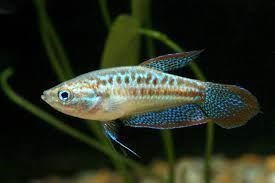
THE BEST CONDITIONS OF THE AQUARIUM:
Minimum size of the aquarium from 40 liters, for a group of at least 5 individuals, since they like the company of their congeners.
Preferably specific, although it can live well accompanied by other small fish with a peaceful behavior, it must have little current and the aquarium must not be very high, it must be abundantly planted and it is preferable to include floating plants to darken it, preferably it will occupy the upper area of the aquarium, if the fish is not comfortable, it will be elusive and spend the day hidden among the plants.
Soft and acid water.
With hardness between 2° and 10° GH.
Upper and middle level.
pH: Between 5.8 and 7.
Temperature: between 24° and 30° C.
If a tank has too bright lighting and large aggressive inhabitants, the foamy gourami becomes very uncomfortable and loses all of its appeal.
The fish does not go out into the open space, it hides from its aquarium mates and excessive light.
It is also important to note that the glossy gourami breathes with atmospheric air from the surface of the water, and fish must have access to it.
Tank water temperature should be: 25°C to 28°C: 77°F to 83°F.
pH of 6.0 – 7.5.
dH of 5 – 19.
A small tank is enough to keep a couple of fish.
It is recommended to keep them in a school, it will require a larger tank.
It can be quite small, but no less than 50 liters or 10 gallons in capacity.
Although this is not a scalar fish, it is best to keep the fish in a small group of about 5-6 species.
It is desirable that the females prevail, since the males depend more on the territory.
From time to time you can hear some soft sounds from the tank. They are like the sound of the cricket pitch or the door groaning.
During their mating game, excited glowing gourami make this specific growling sound.
The fish that live in my tank most often "sing" at night, when the tank lighting is off, but the room light is on. At this time they begin their mating games and swim together, spreading their fins and "grunting".
This fish is very hardy so it is a great fish for beginners.
They need to be kept in a tank of at least 132 liters; must have many open areas to swim, offer the best space to this Gouram with this Eco Pump Aquarium with Filter.
A great special product to emit a flow in the fish tank, it has a maximum of 600l/h and a power of 8W. The maximum pressure altitude is represented at 1.3m as a pre-filter.
It is a piece of equipment that also emits little noise, so it is ideal for maintaining the health of the new fish in the aquarium. And, it has the fabulous energy saving specification.
At Glu Glu Pet we recommend the following products:
- Aquarium kits.
- External or glass filters.
- Cascade filters.
- Internal filters.
- Breeding filters.
- Filter material.
- heaters.
- Thermometers.
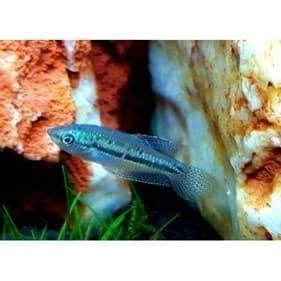
FOR YOUR BEST CARE YOU MUST KNOW ITS BEHAVIOR AND COMPATIBILITY:
You should keep sparkling gourami separate from other fish for one more reason.
Even if they have peaceful and non-aggressive, but active tankmates, the fish becomes the last to get the food.
Another thing is that while you are raising the sparkling gourami, unlike other tank fish, it takes care of its eggs, larvae and juveniles.
In that they do not even try to eat their juveniles, despite the fact that there was no food in a tank for a long time.
Any small peaceful fish like guppy, platy, honey gourami, pygmy cory will make a good tank mate for the sparkling gourami.
The fish looks good against small tank plants with leaves and snags.
It can be kept together with the shrimp, although sometimes the foamy gourami may pinch the red cherry barbels or body, but it never does any serious damage.
THE BEST CARE OF THE TRICHOPSIS PUMILA FISH OR SPARKLING GURAMI:
The size of the aquarium needed depends entirely on the species you choose.
Water conditions and suitable tank mates also depend on the species you want to keep.
However, there are a number of things that all gouramis need.
Live plants provide many places to shelter and hide, and some species even use them as a food source. Most species require a very well planted tank.
You will also need to clean your tank. Regular water changes are needed to remove nitrate buildup, which can be dangerous to fish in large quantities.
Sparkling gouramis are hardy fish that don't require a lot of care.
Water parameters must be kept in the range we mentioned above and levels must be closely monitored. Weekly 25% water changes are also needed.
This species is easily startled by loud noises or fast flowing water. Therefore, placing your aquarium in a quiet place is a good option.
His love of hiding all over the tank has been mentioned. If there are not enough plants in your aquarium, the fish will become stressed. When fish are stressed, there is a chance that they will jump out of the tank.
Try placing some decorations in various places. That will not only allow you to customize the tank, but also provide additional spaces to explore.
Sparkling gouramis are not prone to any disease, but it helps to keep an eye out for any signs of illness. For example, one of the most common diseases with freshwater aquarium fish is White Spot Disease (Ichthyophthyriosis).
It can be recognized by the appearance of many white spots all over the fish.
If you suspect your fish has been contaminated, get medication to control the disease as soon as possible. If no action is taken, this condition is likely to be fatal to all fish in the tank.
Overfeeding is also a common problem with Gouramis. Once again, be sure to follow the instructions in the diet section above.
At Glu Glu Pet we recommend the following products:
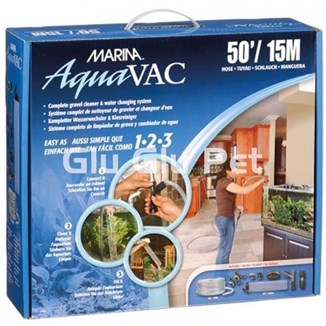

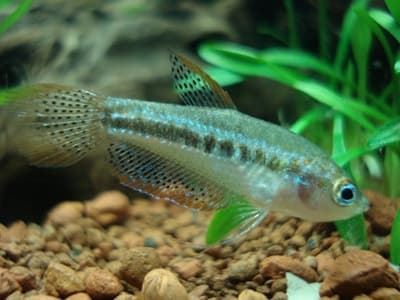
THE HEALTH OF THE FISH TRICHOPSIS PUMILA OR SPARKLING GURAMI:
Dwarf Guru Disease is a viral infection that currently has no cure and can be fatal.
Your fish will lose body weight and appetite and may start swimming in circles.
They are also susceptible to other common diseases such as:
- Ich – white pimple like bumps all over the body, cloudy eyes, loss of appetite, and rapid breathing.
- Fin rot – torn and tear-like fins that are the result of a bacterial infection.
- Fungal diseases – growths on the skin, fins, gills and eyes.
- Parasitic worms that live in the body of a fish, draining all its nutrients, weakening the fish.
Most of these diseases can be prevented as long as the tank is kept clean and the fish calm and happy. If the fish ever get one of these diseases, they can usually be cured with medication.
At Glu Glu Pet we recommend:
